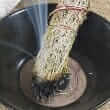Background
- Mugwort is a perennial herb native to Europe, Asia, and northern Africa. It pollinates mainly from July to September, although it may flower throughout the year, depending on the climate. The Chinese have used dried mugwort leaves (moxa) in moxibustion for centuries. Moxibustion is a method of heating specific acupuncture points on the body to treat physical conditions. Mugwort is carefully harvested, dried and aged, and then shaped into a cigar-like roll. This "moxa" is burned close to the skin to heat the specific pressure points.
- Mugwort leaf and stem have been used medicinally as a digestive stimulant and to promote menstruation. The nervine action of mugwort is thought to aid in depression and ease tension. Traditionally, mugwort was believed to provide protection from fatigue, sunstroke, wild animals, and evil spirits.
- No clinical studies have been performed on the use of mugwort as a medical treatment, although an extract from the related Artemisia annua suggests some promise in treating malaria. Dried mugwort (moxa) has been used in moxibustion to treat cancer, but there is no scientific evidence to support this use. Most research on mugwort has focused on its allergenic properties, as its pollen affects 10-14% of the patients suffering from pollinosis in Europe.
References
- Bauer R, Himly M, Dedic A, et al. Optimization of codon usage is required for effective genetic immunization against Art v 1, the major allergen of mugwort pollen. Allergy 2003;58(10):1003-1010.
View Abstract - Darsow U, Vieluf D, Ring J. Evaluating the relevance of aeroallergen sensitization in atopic eczema with the atopy patch test: a randomized, double-blind multicenter study. Atopy Patch Test Study Group. J Am Acad Dermatol. 1999;40(2 Pt 1):187-193.
View Abstract - Figueroa J, Blanco C, Dumpierrez AG, et al. Mustard allergy confirmed by double-blind placebo-controlled food challenges: clinical features and cross-reactivity with mugwort pollen and plant-derived foods. Allergy 2005;60(1):48-55.
View Abstract - Gilani AH, Yaeesh S, Jamal Q, et al. Hepatoprotective activity of aqueous-methanol extract of Artemisia vulgaris. Phytother Res 2005;19(2):170-172.
View Abstract - Jimeno, L., Duffort, O., Serrano, C., et al. Monoclonal antibody-based ELISA to quantify the major allergen of Artemisia vulgaris pollen, Art v 1. Allergy 2004;59(9):995-1001.
View Abstract - Kurzen M, Bayerl C, Goerdt S. [Occupational allergy to mugwort]. J Dtsch Dermatol.Ges. 2003;1(4):285-290.
View Abstract - Osterballe M, Hansen TK, Mortz CG, et al. The clinical relevance of sensitization to pollen-related fruits and vegetables in unselected pollen-sensitized adults. Allergy 2005;60(2):218-225.
View Abstract - Palacin A, Cumplido J, Figueroa J, et al. Cabbage lipid transfer protein Bra o 3 is a major allergen responsible for cross-reactivity between plant foods and pollens. J Allergy Clin Immunol 2006;117(6):1423-1429.
View Abstract - Ramezani M, Fazli-Bazzaz BS, Saghafi-Khadem F, et al. Antimicrobial activity of four Artemisia species of Iran. Fitoterapia 2004;75(2):201-203.
View Abstract - Rossi RE, Monasterolo G. A pilot study of feasibility of ultra-rush (20-25 minutes) sublingual-swallow immunotherapy in 679 patients (699 sessions) with allergic rhinitis and/or asthma. Int J Immunopathol.Pharmacol 2005;18(2):277-285.
View Abstract - Sakagami H, Matsumoto H, Satoh K, et al. Cytotoxicity and radical modulating activity of Moxa smoke. In Vivo 2005;19(2):391-397.
View Abstract - Schmid-Grendelmeier P, Holzmann D, Himly M, et al. Native Art v 1 and recombinant Art v 1 are able to induce humoral and T cell-mediated in vitro and in vivo responses in mugwort allergy. J.Allergy Clin.Immunol. 2003;111(6):1328-1336.
View Abstract - Tuekpe MK, Todoriki H, Sasaki S, et al. Potassium excretion in healthy Japanese women was increased by a dietary intervention utilizing home-parcel delivery of Okinawan vegetables. Hypertens.Res 2006;29(6):389-396.
View Abstract - Vermeulen AM, Groenewoud GC, de Jong NW, et al. Primary sensitization to sweet bell pepper pollen in greenhouse workers with occupational allergy. Clin Exp Allergy 2003;33(10):1439-1442.
View Abstract - Wopfner N, Gadermaier G, Egger M, et al. The spectrum of allergens in ragweed and mugwort pollen. Int Arch Allergy Immunol. 2005;138(4):337-346.
View Abstract







